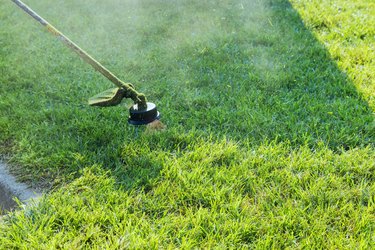
String trimmers, often referred to as weed whackers, are small but mighty. Consisting of a trimmer head at one end, an engine at the other and a metal shaft connecting the two, there are only a handful of ways for a string trimmer to malfunction. Don't buy a new string trimmer until you're sure your existing string trimmer can't be salvaged. A lot of common issues have fairly quick fixes.
Tip
Always wear eye protection, sturdy closed shoes, long pants, and work gloves when working with a string trimmer, even if it's not currently working. Keep kids and pets out of the area. Accidents can happen very quickly, so if the string trimmer is connected to power, handle it as if it's going to start at any moment.
Video of the Day
1. String Trimmer Won’t Start
While a cordless battery-powered string trimmer, a gas-powered string trimmer and an electric string trimmer function in essentially the same way once they're running, they start in different ways. An electric string trimmer may not start because it's connected to a dead outlet and/or broken extension cord. A battery-powered trimmer may fail to start because its charge is too low.
Video of the Day
When a gas-powered string trimmer won't start, checking the gas tank is always a good first step. The trimmer won't start if the tank is empty or nearly there. A gas string trimmer may also seize or smoke when you try to start it if the gas-to-oil ratio in the tank is wrong. Mixing the right ratio (which varies by model) is critical in order to start the trimmer.
2. String Trimmer Won’t Stay Running
Clogged filters are often to blame when a string trimmer starts but then stalls. Check the user manual for guidance on locating and cleaning any air filters, spark arrest screens and/or fuel filters used in your trimmer. A clogged carburetor could also be the culprit. Removing it and using carburetor cleaner to scrub away debris should improve engine performance.
3. String Trimmer Is Leaking Fuel
Fuel leaks only affect gas-powered string trimmers. If your string trimmer is leaking fuel, first check whether the gas tank's cap is securely tightened. Assuming the cap isn't cracked or loose, the fuel line is probably the source of the leak. It's common for this line to become brittle and develop cracks over time. The specifics will vary by model, but replacing the fuel line is generally a manageable task for the average person.
A new fuel line may cost you less than $10 at your home improvement store. Size varies by trimmer, so look up your model's specs or buy a fuel line kit that includes lines of multiple sizes. This project also requires needle-nose pliers, which will be helpful for pulling the old lines off the carburetor and out of the fuel tank and maneuvering the new line into place.
Safety is paramount while working with and around fuel. Get rid of anything that could spark and ignite the fuel. Wearing safety gloves, make sure to drain all the liquid out of the string trimmer's tank and into a sealed gas can before replacing the fuel line.
4. Trimmer Head Won't Spin
The clutch connects to the trimmer head via a driveshaft. The clutch is responsible for making the trimmer head spin, creating the centrifugal force that makes the trimmer line move fast enough to cut through things. When the head doesn't spin, it's generally because of a problem with the clutch or driveshaft. A broken clutch can be replaced with a new one. A broken driveshaft may be repaired, but it might be more economical to invest in a new string trimmer.
5. Trimmer Line Won’t Cut
If your string trimmer powers on and spins properly but your weeds aren't getting any shorter, there's likely a problem with the trimmer line itself. (Be sure to turn off the trimmer's power, disconnect the spark plug wire and empty the fuel tank in a gas trimmer before working on the trimmer line.) It may be that the line has become too short and doesn't extend far enough out of the trimmer head to effectively cut anything.
With a bump-and-feed trimmer head, tapping the head on the ground should advance more line. Many newer models have a spool button that can be pressed to release more line or will automatically feed more line when necessary. If using your model's method doesn't feed more line out of the trimmer head, it may be that the line is stuck or has become too short and needs to be replaced. Follow the manufacturer's instructions to restring your string trimmer as different trimmer heads are strung in different ways.